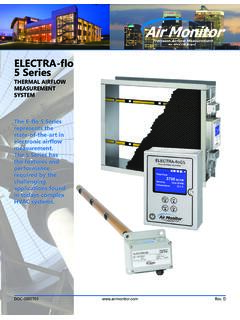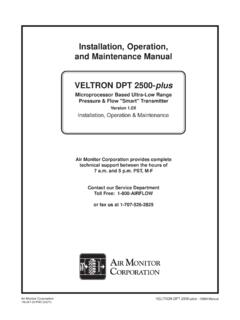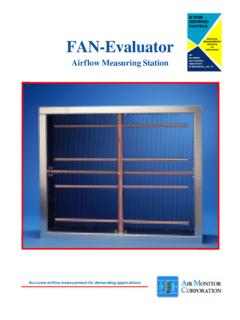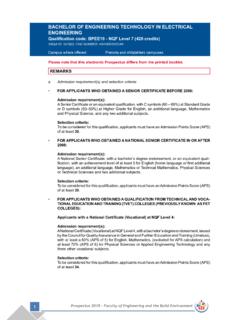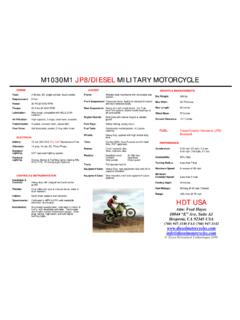Transcription of CEM SYSTEMS - Air Monitor Corporation
1 CEM SYSTEMSC ontinuous Emissions MonitoringProven solutions for a tough industryAIR MONITORPOWER DIVISION40 CFR 75 SummaryOn October 26, 1992, the Environmental Protection Agency (EPA)signed into law Part 75 of the Code of Federal Regulationsgoverning Continuous Emission Monitoring. First proposed inDecember 1991 and subjected to extensive public review, thefinalized version of 40 CFR 75 follows. The full version of 40 CFR 75 outlines the purpose, standards, certification process,and recordkeeping requirements for monitoring seven emissionparameters:SO2 concentrationOpacityCO2 concentrationVolumetric flowNOx concentrationDiluent concentration (O2 or CO2)Moisture concentrationVolumetric Flow Monitoring SystemsPrior to receiving certification by the EPA, a flow monitoringsystem must satisfy continuous emission monitoring requirementsvia a detailed test procedure to verify that the performance andsystem configuration is within the EPA mandated requirementsrelative to:Measurement LocationInterference CheckCalibration ErrorRelative EPA Requirements for Continuous Emissions Monitoring (CEM)Bias is a systematic error resulting in measurements that will beconsistently low or high relative to the true flow monitors that exhibit the need for low bias will not passcertification.
2 Flow monitors that exhibit the need for high biascan have the Monitor output values adjusted by a singlecorrection January 1, 2000 the accuracy requirement forvolumetric flow was lowered to 10%. Flow monitors achievinga relative accuracy of 7-1/2% were granted a reduction in RATA testing frequency from semi-annually to selection of probe location and quantity, combined withfield calibration prior to certification permits the Air Monitor flowmonitoring system to achieve annual RATA AccuracyEPA defines an appropriate location for installation of a CEMS ystem by referencing 40 CFR 60, Appendix A, Method 2. Thedesired location would be one with a minimum of eight stack orduct diameters downstream and two diameters upstream ofany flow disturbance. Minimum siting requirements are twodownstream diameters and one-half upstream diameter of anyflow disturbances. Provisions are made in 40 CFR 75 to petitionthe EPA for an alternate monitoring location when the minimumsite requirements cannot be LocationRegardless of the technology used to measure flow, all flowmonitoring SYSTEMS must include a means to ensure the in-stackequipment remains free of obstructions that would affectongoing measurement accuracy.
3 For differential pressure flowmonitors, the requirement is for an automatic timed, periodicback purge using compressed air to keep the probe sensingports clean and expel condensation of wet gases. Air Monitormeets this requirement with its AUTO-purge/CEM CheckCalibration error is calculated as the percentage differentialbetween a reference value and the actual monitorinstrumentation reading. Calibration error must be determinedduring the certification process, then daily, and periodicallythereafter. The daily check of calibration must verify that theerror has not deviated more than percent from the referencevalue, with excessive deviation necessitating instrumentationrecalibration. Air Monitor 's instrumentation, consisting of itsMASS-tron/CEM transmitter with AUTO-cal function, providesdaily reporting of calibration flow outputs for calculation ofcalibration error in the ErrorRATA FREQUENCY REQUIREMENTSFOR FLOW MONITORING SYSTEMSR elative RATA FrequencyTo assist in complying with the Clean Air Act's stringent emissionmeasurement standards, Air Monitor has assembled a costeffective integrated system consisting of in-stack flowmeasurement equipment and companion instrumentation toprovide continuous, accurate, and reliable volumetric flowmonitoring for stacks and ducts of any size and ComponentsIn-Stack Flow Traverse Probe(s)Required is the means to accurately Monitor the average flowrate and temperature of the stack emissions.
4 Flow rate monitoringis performed by sensing individual flow components at multiplepoints (traversing) across one or more diameters for circularstacks or along multiple parallel traverses for rectangular stacks,and averaging the obtained values. Average temperaturemeasurement is achieved using one or more temperature probesto obtain a single full traverse of a Air Monitor STACK-probe is an airflow traverse probe basedon differential pressure (Pitot-Fechheimer) technology formeasuring airflow; the same technology that will be used duringthe certification process to verify relative accuracy of the flowmonitoring system . Each STACK-probe consists of two separateround tube self-averaging manifolds; one to measure the stacktotal pressure, and the other to measure stack static Pitot-Fechheimer ports are positioned on each manifoldon an equal area basis (for rectangular stacks) or on an equalconcentric area (for circular stacks).
5 Similarly, average stacktemperature is measured using a temperature probe withmultiple sensing elements spaced along the probe engineered truss type design of the STACK-probe utilizestubular structural materials welded to a 6", 150# raised facepipe flange, permitting cantilever probe mounting in evenextremely large stacks. Standard Type 316 stainless steelconstruction ensures long-term durability and continuingaccuracy in most installations, with materials such as HastelloyC22 and Inconel available for extreme temperature and/orseverely corrosive a basic instrument, the STACK-probe does not require anyinitial or periodic calibration to measure flow accurately. As apassive device with no moving parts or active electrical circuits,removal of the STACK-probe from the stack after installation forrepair or calibration is not Back PurgeRequired for differential pressure flow monitoring SYSTEMS is aback purging means to ensure that the in-stack flow monitorprobe has its pressure sensing ports and averaging manifoldmaintained free of particulate build-up and vapor activated by Air Monitor 's MASS-tron/CEM or the DataAcquisition system (DAS), the AUTO-purge/CEM Systemsequentially operates a combination of failsafe valves toautomatically back purge the sensing lines and the STACK-probes with high volume/high pressure compressed air for ashort duration, while simultaneously isolating the transmitterfrom AUTO-purge/CEM construction mounts all componentsin a steel NEMA 4 rated enclosure, with all wetted parts made ofcopper or brass.
6 The AUTO-purge/CEM is optionally available ina stainless steel NEMA 4X enclosure, with stainless steel wettedparts for corrosive Air Monitor MASS-tron/CEM multi-variable, ultra-lowdifferential pressure transmitter converts the temperature anddifferential pressure flow signals received from the in-stacktraverse probe(s) into a continuous output signal representingthe volumetric flow in SCFM (wet or dry basis) being dischargedinto the meet the calibration error reporting requirements of 40 CFR75, the MASS-tron/CEM used in stack flow monitoringapplications is equipped with AUTO-cal circuitry. Once every24 hours, the MASS-tron/CEM executes an AUTO-cal calibrationcycle, during which the transmitter output signal is held at thelast sensed flow level. Sequentially activated valves exposethe MASS-tron/CEM transmitter to reference pressures for zeroand span resulting in corresponding calibration flow outputs,after which the MASS-tron/CEM resumes normal flow addition to the local display of information, the MASS-tron/CEM provides outputs to the Data Acquisition system (DAS) for:Temperature F4-20mADCAUTO-cal AcknowledgmentDry ContactAUTO-purge AcknowledgmentDry ContactSCFM4-20mADC*Zero Calibration Error Signal4-20mADC*Span Calibration Error Signal4-20mADC**Serial Output.
7 See Figure MASS-tron/CEM is available in either a 19" rack mount or aNEMA 4 enclosure, with a NEMA 4X stainless steel enclosureoptionally ReportingData Reporting & Installation RequirementsT0T1T2T3T4 T0 MASS-tron/CEM internal timer or external dry contact from DAS initiates AUTO-cal cycle. Transmitter output signal for stack flow isheld at the last flow value during the AUTO-cal cycle. T1 AUTO-cal relay contact closes. Zero flow output signal begins. T2 AUTO-cal relay contact opens. Flow output signal goes to 4mADC. T3 AUTO-cal relay contact closes. Calibration flow output signal begins. T4 AUTO-cal relay contact opens. Calibration flow output signal ends. Transmitter returns to reporting actual stack Air Requirement. 80 to 125 psig at 100 CFM, oil and dirtfree. 1 to 24 purge cycles per day, with a duration of less than 2minutes during which compressed air is Air Requirement.
8 25 to 120 psig instrument airsupply. Per ISA , required for AUTO-span equipped MASS- Temperature. 32 F to 140 F for the AUTO-purge/CEM panel; 60 F to 80 F for the MASS-tron/CEM. Recommendedinstallation is within the environmentally controlled analyzerinstrumentation Tank (strongly recommended). Requirescoalescing filter, pressure regulator, and check valve at the stack traverse 80 gallons2 stack traverses 120 gallonsElectrical Power Requirements. 120 VAC, 10 amp for heaterequipped AUTO-purge/CEM panel; 120 VAC, 1 amp for MASS- from Accumulator Tank to AUTO-purge/CEM ' maximum length, 1/2" pipe (minimum). Recommend locatingaccumulator tank as close as possible to AUTO-purge/CEM Size from AUTO-purge/CEM to from AUTO-purge/CEM Panel to MASS-tron/CEM pre-manufactured umbilical or SS RequirementsAUTO-cal Relay ContactNormal Flow ValueFlow and AUTO-cal SignalsDistanceTube Size< 25'1/2" tube25' to 50'3/4" tube> 50'1" tubeDistanceTube Size< 25'1/4" tube25' to 200'3/8" tube> 200'1/2" (100%) (70%) (0%)STACK-probe w/Temperature and Insert PortTypical InstallationIn-Stack Probe Configurations Single-Wall StacksDual Traverse SchematicTypical InstallationAUTO-purge/CEM Located on the Stack PlatformMASS-tron/CEM Located in the Instrumentation EnclosureFlow Monitor Probe and Test Port LocationsSTACK-probe ports should be located on a different axisthan flow Monitor probe(s) to minimize disturbingthe flow being sensed by the probe(s)
9 During40 CFR60, Appendix A, Method 2 distance from the flow Monitor probe(s) ortest ports to an upstream flow disturbance is 2 Dminimum, 8D desirable. The distance from theflow Monitor probe(s) or test ports todownstream flow disturbance is D/2 minimum, distance between the flow Monitor probe(s)and the test port planes is usually only 6" to 12"due to practical limitations relative to stackplatform access. Flow disturbances created bythe test probe may affect flow Monitor readingsduring 40 CFR60, Appendix A, Method 2 as flow disturbances are: Any stack mounted equipment or structure thatprotrudes or extends out into the air stream. Any dimensional changes in the stack. Any directional changes in the ports should be located on the same plane or elevation asthe flow Monitor probe(s) to minimize disturbing the flow beingsensed by the flow Monitor probe(s) during 40 CFR60,Appendix A, Method 2 test ports cannot be located on the same plane or elevationas the flow Monitor probe(s) due to insufficient space orclearance, locate the test ports 2D upstream of the flowmonitor probe(s).
10 The distance from the flow Monitor probe(s) or test ports to anupstream flow disturbance is 2D minimum, 8D desirable. Thedistance from the flow Monitor probe(s) or test ports todownstream flow disturbance is D/2 minimum, 2D as flow disturbances are: Any stack mounted equipment or structure that protrudesor extends out into the air stream. Any dimensional changes in the stack. Any directional changes in the (7/07)Air Monitor 's Product Families of Air & Coal Flow Measurement Box 6358 Santa Rosa, CA 95406 P: 800-AIRFLOW F: Individual Burner Airflow MeasurementThe IBAMTM Individual Burner Airflow Measurement probe is ideally suited for new orretrofit applications where a reduction in plant emissions and improvement in efficiencycan be obtained through accurate measurement of burner secondary airflow. TheIBAMTM probe has been designed to accurately measure in the particulate laden, highoperating temperature conditions found in burner air Combustion Airflow Management SystemThe CAMSTM Combustion Airflow Management system has been designed to reliablyand accurately measure airflow in combustion airflow applications.
